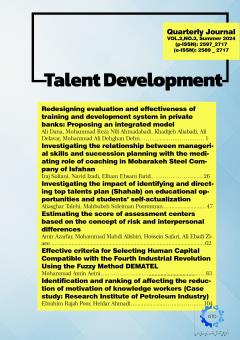برآورد نمره کانونهای ارزیابی مبتنی بر مفهوم ریسک و تمایزات میانفردی
الموضوعات : الگوهای مدیریت استعداد سرمایه های انسانیامیر آذرفر 1 , محمدمهدی علیشیری 2 , حسین صفری 3 , علی عبادی 4
1 - دانشکده مدیریت دانشگاه تهران
2 - دانشگاه امام صادق
3 - دانشگاه تهران
4 - دانشگاه تهران
الکلمات المفتاحية: کانون ارزیابی, برآورد نمره نهایی, نمره کانون ارزیابی مبتنی بر ریسک, تمایزات میان فردی,
ملخص المقالة :
از جمله روشهای مورد استفاده برای سنجش و ارزیابی کارکنان، استفاده از کانون ارزیابی است. کانونهای ارزیابی معمولا از روایی مناسبی در سطح ابزار برخوردار هستند اما در سطح مدل برآورد نمره نهایی کانونهای ارزیابی، ضعفهایی وجود دارد. این پژوهش به طراحی ارائه روشی به منظور برآورد نمره نهایی کانونهای ارزیابی مبتنی بر مفهوم ریسک و با در نظر گرفتن تفاوتهای میان فردی است. برای این منظور از دادههای کانون ارزیابی 800 نفر از مدیران کشور استفاده شده است. در این پژوهش نه مدل متفاوت طراحی و ارزیابی شده و در نهایت مدلی که کمترین میزان خطا را دارا بوده است، به عنوان مدل منتخب ارائه شده است.
1) Bowen, D., & Ostroff, C. (2004). Understanding HRM- Firm Performance Linkage: The Role of the 'Strength' of the HRM System. Academy of Management Review, 203-221.
2) International Task Force on AC Guidelines. (2009). Guidelines and ethical considerations for assessment center operations. International Journal of Selection and Assessment, 243-253.
3) Gaugler, B., & Pohley, K. (1997). A Survey of Assessment Center practices in Organizations in the United States. PERSONNEL PSYCHOLOGY, 71-91.
4) Huck, J. (1973). Assessment centers: A review of the external and internal validities. PERSONNEL PSYCHOLOGY, 191-212.
5) Lievens, F. (2009). Assessment centres: A tale about dimensions, exercises, and dancing bears. European Journal of Work and Organizational Psychology, 102-121.
6) Lane, S., & Stone, C. (2006). Performance assesment. Educational measurement, 387-424.
7) Adamo, G. (2003). Simulated and standardizes patient in OSCEs: Achievements and challenges. Medical Teacher, 262-270.
8) Pecheone, R., & Chung, R. (2006). Evidence in teacher sducation- The Performance Assessment for California Teachers (PACT). Journal of Teacher Education, 22-36.
9) Harvey, P., Velligan, D., & Bellack, A. (2007). Performance- based measures of functional skills: Usefulness in clinical treatment studies. Schizophrenia Bulletin, 1138-1148.
10) Borman, W. (2012). Mimensions, task and mixed models: An analysis of the three diverse perspectives on assessment centers. The psychology of assessment center, 309-320.
11) Tell, R., & Burnett, D. (2003). A perdonality trail-based interactionist model of job performnce. Journal of Applied Psychology, 500-517.
12) Campion, M., & Ployhart, R. (2013). Assessing personality with situational judgment measures: Interactionist psychology operationalizes. New York: Handbook of personality at work.
13) Jansen, A., Melchers, K., Leivens, F., Kleinmann, M., Brandli, M., Fraefel, L., & Konig, C. (2013). Situation assessment as an ignored factor in the behavioral consistency paradigm underlying the validiy of personnel selection peocedures. Journal of Applied Psychology, 326-341.
14) Ulrich, D. (1989). Measuring human resource effectiveness: Stakeholder, index, and relationship approaches. Human Resource Planning, 301-315.
15) Woehr, D., Arthur, W., & Jr. (2003). The construct-related validity of assessment center ratings: A review and meta-analysis of the role of methodological factors. Journal of Management, 231-258.
16) Struch, M., Frank, F., & Amato, A. (1980). Effects of assessor training on subsequent performance as an assessee. Journal of Assessment Center Technology, 17-22.
17) Huck, J., & Bray, D. (1976). Management assessment center evaluations and subsequent job performance of white and black females. PERSONNEL PSYCHOLOGY, 13-30.
18) Schmitt, N., Jennings, D., & Toney, R. (1999). Can We Develop Measures of Hypothetical Constructs? Human Resource Management Review 9, 169-183.
19) Gaugler, B., Rosenthal, D., Thornton, G., & Bentson, C. (1987). Meta-analysis of assessment center validity. Journal of applied psycjology, 493.
20) Gatewood, R., Feild, H., & Barrick, M. (2010). Human Resource Selection. Cengage Learning.
21) George, W. (1971). Development and Use of Weighted Application Blank. University of Minnesota.
22) Lyer, S., & Sharda, R. (2009). Prediction of athletes performance using neural networks: An application in cricket team selection. Expert System with Applications, 5510-5522.
23) Maszczyk, A., Golas, A., Pietraszewski, P., Roczniok, R., Zajac, A., & Stanula, A. (2014). Application of neural and regression models in sports results prediction. Procedia-Soci Behavio Sci.
24) Leung, C., & Joseph, k. (2014). Sports data mining: predicting results for the college football games. Procedia Computer Science, 710-719.
25) Knottenbelt, W., Spanias, D., & Madurska, A. (2012). A common-opponent stochastic model for predicting the outcome of professional tennis matches. Computer & Mathematics with Applications, 3820-3827.
26) Salas, E., Shuffler, M., Thayer, A., Bedwell, W., & Lazzara, E. (2015). Understanding and improving teamwork in organizations: A scientifically based practical guide. Human resource management, 599-622.
27) Sanchez-Anguix, V., Julian, V., Botti, V., & García-Fornes, A. (2013). Tasks for agent-based negotiation teams: Analysis, review, and challenges. Engineering Applications of Artificial Intelligence, 26(10), 2480-2494.
28) Wahesh, E., & Myers, J. (2014). Principles and practices of leadership excellence: CSI chapter presidents' experience, preceived competence, and rankings of importance. Journal of Counselor Leadership and Advocacy, 83-97.
29) Lin, F., Fardad, M., & Jovanović, M. R. (2014). Algorithms for leader selection in stochastically forced consensus networks. IEEE Transactions on Automatic Control, 59(7), 1789-1802.
30) Zhang, L., & Zhang, X. (2013). Multi-objective team formation optimization for new product development. Computers & Industrial Engineering, 64(3), 804-811.
31) Wang, J., & Zhang, J. (2015). A win–win team formation problem based on the negotiation. Engineering Applications of Artificial Intelligence, 44, 137-152.
32) Tavana, M., Azizi, F., Azizi, F., & Behzadian, M. (2013). A fuzzy inference system with application to player selection and team formation in multi-player sports. Sport Management Review, 16(1), 97-110.
33) Meneghel, I., Martínez, I. M., & Salanova, M. (2016). Job-related antecedents of team resilience and improved team performance. Personnel Review.
34) Ding, X., Li, Q., Zhang, H., Sheng, Z., & Wang, Z. (2017). Linking transformational leadership and work outcomes in temporary organizations: A social identity approach. International Journal of Project Management, 35(4), 543-556.


